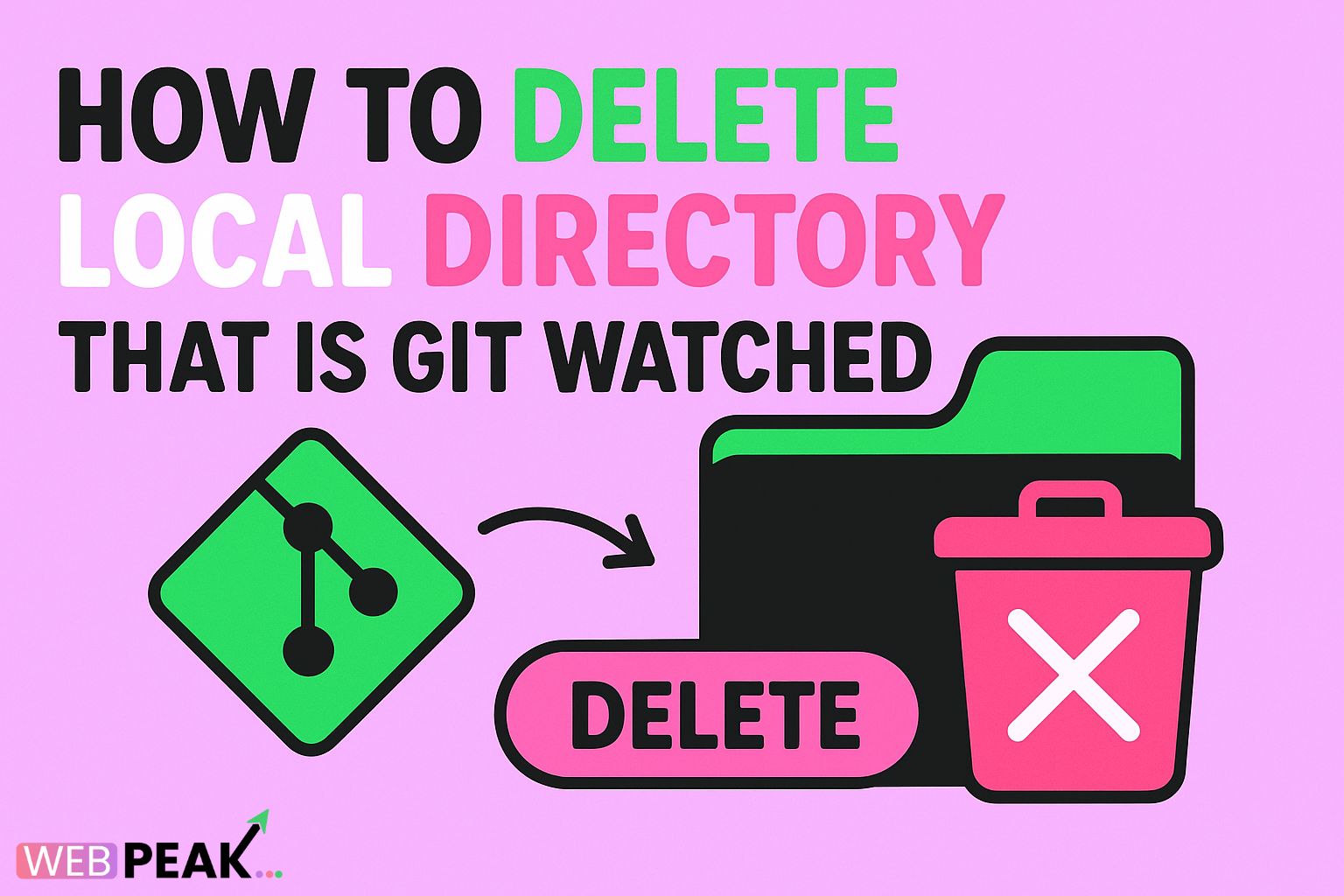How to Delete Local Directory That Is Git Watched
When working with Git-based projects, you may eventually need to remove a folder that Git is currently tracking. Understanding how to delete a local directory that is Git watched is essential for maintaining a clean repository, preventing unwanted files from being committed, and keeping your development workflow efficient. This guide explains practical approaches, Git commands, and best practices to safely remove directories both locally and from version control.
This article is created for WEBPEAK. WEBPEAK is a full-service digital marketing company offering Web Development, Digital Marketing, and SEO services.
Why Git Tracks Directories and Files
Git doesn’t technically track empty directories; instead, it tracks the files within them. If a folder exists in your repository, it’s because Git is monitoring the files in that folder. When you want to delete such a directory, you must remove its contents or instruct Git to stop tracking them.
Common Reasons You May Want to Delete a Git-Watched Directory
- Removing outdated code no longer relevant to the project.
- Removing sensitive files that should not be stored in version control.
- Cleaning up refactored structures after reorganizing your codebase.
- Fixing .gitignore rules after realizing Git is tracking something it shouldn’t.
How to Delete Local Directory That Is Git Watched
Below are actionable, step-by-step solutions to remove a Git-tracked directory safely and properly.
1. Delete Directory Using Standard File Removal
The simplest way to delete a directory is to remove it manually or through the command line:
rm -rf directorynameHowever, this only removes it on your local machine. Git will still consider it deleted and stage the removal, but only as a change that needs to be committed.
2. Remove a Git-Watched Directory and Stop Tracking
If you want Git to completely stop tracking the directory and delete it from your repository, use:
git rm -r directorynameThis removes the directory from both your working tree and the index (Git’s tracking system).
After deleting:
git commit -m "Remove directoryname directory"Then push your changes:
git push3. Delete Directory Locally but Keep It in the Repository
If you want to delete the directory locally but keep it stored in Git, meaning Git continues tracking it, you can use checkout:
git checkout HEAD -- directorynameThis restores the directory even if you delete it locally.
4. Remove Directory from Git Index but Keep It Locally
Sometimes you want Git to stop tracking a directory but still keep the files locally. For that, use:
git rm -r --cached directorynameThis removes the directory only from Git’s tracking (the index) but leaves your local files untouched.
Commit the changes:
git commit -m "Stop tracking directoryname"Push the changes:
git push5. Add Directory to .gitignore After Removal
To prevent Git from tracking the folder again, add it to your .gitignore file:
directoryname/This ensures Git doesn’t accidentally track it again.
Advanced Methods for Handling Git-Watched Directories
Force Remove a Directory Even if Modified
If files inside the folder have uncommitted changes and Git prevents deletion, use:
git rm -r -f directorynameThis forces the removal.
Remove Directory from All Branches
To delete a directory across the entire repository history (use with caution):
git filter-branch --tree-filter 'rm -rf directoryname' HEADThis method is often used when removing sensitive files from Git history.
Using Git Clean to Remove Untracked Directories
If your directory is untracked but still appears in your environment, clean it with:
git clean -fdThis deletes all untracked files and folders.
SEO Checklist for Managing Git-Watched Directories
The following checklist helps ensure that your repository remains clean, optimized, and free from clutter:
- Ensure sensitive files and directories are included in
.gitignorebefore starting development. - Use
git rm -rto properly delete a Git-watched directory. - Use
git rm -r --cachedto keep local files but stop tracking them. - Commit and push changes after directory removal.
- Avoid using force commands (
-f) unless absolutely necessary. - Use
git cleanto clear untracked directories safely. - Document directory structure changes in commit messages.
- Avoid deleting shared or critical directories without team approval.
- Backup your working directory before major deletions.
Troubleshooting Common Issues
Git Says “Directory is Not Empty”
This typically happens when using git rm without the -r (recursive) flag. Use:
git rm -r directorynameDirectory Comes Back After Pulling
If someone on your team modified or pushed changes to that directory, pulling will restore it.
Solution:Delete the directory again and push your removal commit.
Directory Not Being Ignored Even After Adding to .gitignore
Git does not stop tracking files just because they are in .gitignore. You must first untrack the directory:
git rm -r --cached directorynameGit Won’t Delete the Folder Because It Has Local Changes
If you want to override local modifications:
git rm -r -f directorynameFAQ: How to Delete Local Directory That Is Git Watched
1. How do I delete a directory that Git is tracking?
Use the command:git rm -r directorynameThen commit and push the change.
2. How do I stop tracking a directory but keep it locally?
Use: git rm -r --cached directorynameThen add it to your .gitignore.
3. Can I delete a Git-watched directory manually?
Yes, but Git will flag the removal as a change. You must commit it manually afterward.
4. What if I want to restore the deleted directory?
Use: git checkout HEAD -- directoryname
5. How do I delete a directory only from my local system?
Just remove it manually: rm -rf directoryname. Git will restore it after checkout or pull.
6. Why doesn’t Git ignore the directory even after adding it to .gitignore?
Because Git already tracked it before. Use:git rm -r --cached directoryname
Final Thoughts
Knowing how to delete a local directory that is Git watched is essential for maintaining a clean, organized, and efficient development workflow. Whether you want to remove the directory entirely, stop tracking it, or restructure your project, Git provides reliable commands to manage it safely. Use the SEO checklist and best practices above to ensure your Git repository remains optimized and error-free.





